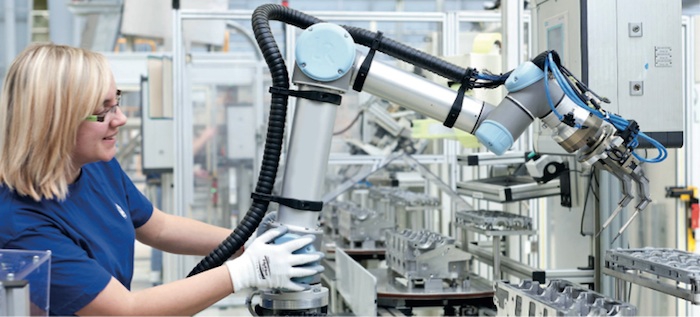
Five ways to help ensure safe operations with collaborative robots
November 28, 2016
By WSPS

Nov. 28, 2016 – Collaborative robots are poised to take off in the next few years, says WSPS consultant Robert Vomiero. With built-in safety limits, sensors and other safety functionality, “cobots” offer exciting benefits — they’re able to work more closely with humans, can be cheaper and easier to integrate and maintain, and promise better cycle time and productivity.
But this doesn’t mean organizations anxious to embrace the new technology can rest easy when it comes to health and safety. Crushing and impact hazards remain, requiring special safety measures and a greater emphasis on certain aspects of your health and safety program.
Types of collaborative operations
CSA standard Z434-2014, Industrial Robots and Robot Systems, categorizes four types of collaborative operations according to the degree of collaboration between humans and robots.
• Safety-rated monitored stop
Equipped with safety-rated stop functionality, the robot stops when in the collaborative workspace at the same time as an operator. Once the human has left the collaborative workspace, the robot can resume operating. This type of collaboration involves occasional interactions between human and robot, and can eliminate the need for operators to load parts into intermediate set jigs or parts nests, and manually restart the operation. “It’s more efficient,” says Vomiero.
• Hand guiding
This enables the operator to guide the robot with a joystick type control located near the end-effector and equipped with an enabling device and emergency stop. This replaces the traditional, and complicated, robot pendant. A manual reduced safety-rated speed function restricts robot speed to a safe limit.
• Speed and separation monitoring
The human and robot work independently within the same space. Robot speed varies based on a safe separation distance between human and robot. If the human comes too close, the robot operation stops. Among the safety features: safety-rated speed functionality, external safety presence sensing devices (i.e., safety laser scanners or cameras), and internal safety-rated soft limits to monitor the human’s position with respect to the robot. The robot acts as an “assistant” to the operator.
• Power and force limiting
“Most people think of this type when we talk about collaborative robots,” says Vomiero. “It’s the only operation where you can have physical contact while the robot is in motion.” Either inherent robot design parameters or on-board safety-rated sensors and control systems limit the power output and force exerted. To further minimize risk, the physical structure is often padded and corners are rounded.
Five ways to reduce risk
“With the exception of power and force limiting robots, you still require a certain degree of separation, as well as safeguarding devices,” says Vomiero, adding that you must also ensure the robot’s safety functions are properly designed, implemented and used. “For instance, setting up our safe zones and distances appropriately.” Here are some key safety activities.
• Familiarize yourself with CSA standard Z434-2014, Industrial Robots and Robot Systems. “It’s the first step in protecting workers,” says Vomiero.
• Ensure you have a strong risk assessment process to determine what safeguarding devices are needed, as well as safe zones, speed, force and power limits for every possible collaborative scenario. “Risk assessments are the cornerstone of the CSA robotics standard, and are mandatory.” Because of the specialized nature of robotics, consider bringing in an outside expert to help develop a robot-specific risk assessment.
• Create a checklist before you purchase to ensure the robots have the right safety features, meet the necessary requirements, and are compliant with the CSA standard and regulations.
• Develop and train workers on safe operating procedures based on both the integrator’s information for use and manufacturers’ instructions. Train everyone who may come into contact with the robot, from operators to maintenance.
• Be sure to include robots and robot cells in monthly inspections. “It’s important to ensure robotic equipment continues operating in a safe manner, and to stay on top of hazards that may develop after installation and over the life of the system,” cautions Vomiero.
This column was previously published in the November/December 2016 issue of Manufacturing AUTOMATION.